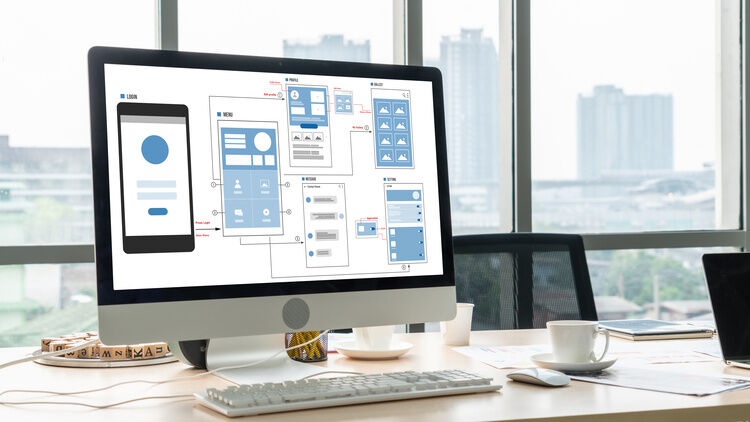What is Content Architecture and Why Does it Matter?

Imagine building a house without blueprints. The result might be chaotic, disorganized, and inefficient. Now, translate that analogy to your digital ecosystem, where your "content" is the structure that needs order. This is where content architecture steps in.
At its core, content architecture is about structuring, organizing, and delivering content efficiently. The behind-the-scenes blueprint ensures the right content reaches the right audience most effectively.
But why does this matter? In a world where online experiences drive business success, poorly structured content can lead to lost customers, reduced engagement, and operational inefficiencies. A well-thought-out content architecture enhances usability and future-proofs your content strategy, allowing scalability and adaptability for evolving business needs.
In this guide, we’ll explore what makes content architecture essential, how it differs from information architecture, its key components, and the tangible benefits it brings.
Content Architecture vs. Information Architecture
While content and information architecture (IA) may seem similar, they serve distinct yet complementary purposes.
Content Architecture
Content architecture focuses on the backend organization of content, including how it’s stored, tagged, and managed. It determines:
- Relationships between pieces of content (e.g., blog posts linked to relevant resources).
- Metadata for categorization (like tags, keywords, or publication dates).
- Workflows for creating, approving, and publishing content.
A robust content architecture ensures consistency, scalability, and flexibility, making it easier to manage growing content libraries.
Information Architecture (IA)
In contrast, IA focuses on the front end—how information is presented and navigated. It’s about user experience (UX), answering questions like:
- How can users easily find what they need?
- How should menus, filters, and navigation paths be structured?
- How should content be visually displayed for clarity?
For example, while content architecture may decide the taxonomy for categorizing blogs, information architecture ensures users can intuitively navigate through categories like "Marketing", "Tech Insights," or "Case Studies."
Both architectures work together: content architecture organizes the backend, and IA ensures this structure translates into a seamless user experience.
Key Elements of a Content Architecture
Creating an effective content architecture involves several foundational elements. Here’s what goes into building a system that works:
1. Content Models
Content models define the structure of different content types, such as blogs, FAQs, or product descriptions. They ensure consistency across all pieces of similar content. For instance, every blog might have these fields:
- Title
- Author
- Published Date
- Categories
- Body Content
A clear content model avoids inconsistencies, making content easier to manage and present
2. Metadata and Taxonomy
Metadata provides descriptive tags for content, such as keywords, dates, and categories. Taxonomy organizes these tags into a hierarchy, enabling better searchability and filtering.
For example:
- Metadata: “Hiking, Outdoor Gear, Summer 2025”
- Taxonomy: “Sports & Fitness > Outdoor Activities > Hiking”
This structured approach allows users and systems to locate relevant content instantly.
3. Workflows and Roles
Effective content architecture includes clearly defined workflows for creating, editing, approving, and publishing content. This streamlines the process and avoids bottlenecks. It also defines roles, such as:
- Authors: Create content.
- Editors: Refine and review content.
- Approvers: Ensure compliance and quality.
4. Modular Content
Modern content architecture often leverages modularity, storing content in reusable blocks. For example, a product description created for an e-commerce site can be repurposed for email marketing or social media posts.
5. Scalability
A future-proof content architecture anticipates growth. It allows for seamlessly adding new content types, categories, and delivery channels without overhauling existing systems.
6. Omnichannel Delivery
Content architecture should account for delivery across multiple platforms. Whether your content appears on a website, app, or IoT device, it should be consistent, adaptable, and easy to deploy.
Benefits of a Smart Content Architecture
Why should businesses invest time and resources into building a robust content architecture? The advantages are numerous:
1. Streamlined Content Management: With well-organized systems, teams can quickly locate and update content, reducing time wasted on inefficiencies.
2. Enhanced User Experience: Structured content ensures users find what they need without frustration. This leads to higher engagement, longer session durations, and better conversion rates.
3. Scalability and Flexibility: A smart content architecture accommodates future growth, enabling businesses to expand without technical hurdles.
4. Faster Go-to-Market: By streamlining workflows, businesses can publish new content or update existing material faster. This agility is especially valuable for time-sensitive campaigns.
5. Improved SEO and Discoverability: Proper taxonomy and metadata make content easier for search engines to crawl and index, boosting visibility and organic traffic.
6. Cross-Channel Consistency: A unified content architecture ensures messaging remains consistent across all platforms—web, mobile, email, and beyond.
7. Actionable Analytics: Organized content allows businesses to analyze performance more effectively, yielding insights that refine content strategies over time.
Real-World Applications of Content Architecture
1. E-commerce Platforms
E-commerce sites often manage thousands of product pages. A solid content architecture ensures products are correctly categorized, making them easy to search, filter, and recommend.
2. Media and Publishing
For online publishers producing daily articles, transparent workflows and metadata help streamline operations and improve audience targeting.
3. Corporate Intranets (web portals)
Internal content architecture organizes training materials, HR resources, and company updates, ensuring employees find the information they need efficiently.
Conclusion
Content architecture is more than a technical framework—it’s a strategic enabler of success in the digital era. By organizing content at its core, businesses can improve efficiency, enhance user experiences, and prepare for scalable growth.
Whether you’re a startup building a content foundation or an enterprise optimizing your digital ecosystem, investing in a well-structured content architecture is a step toward long-term success.
Businesses thrive when content works more brilliantly and users return for more.


